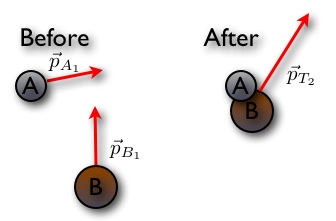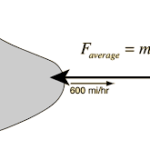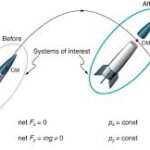Occasionally when objects collide, they bounce off each other as opposed to sticking to each other and traveling with the same speed after the collision. Bouncing off each other is known as rebounding. Rebounding involves a change in the direction of an object; the before- and after-collision direction is different. Rebounding was pictured and discussed earlier in Lesson 1. At that time, it was said that rebounding situations are characterized by a large velocity change and a large momentum change.

From the impulse-momentum change theorem, we could deduce that a rebounding situation must also be accompanied by a large impulse. Since the impulse experienced by an object equals the momentum change of the object, a collision characterized by a large momentum change must also be characterized by a large impulse.
The importance of rebounding is critical to the outcome of automobile accidents. In an automobile accident, two cars can either collide and bounce off each other or collide, crumple up and travel together with the same speed after the collision. But which would be more damaging to the occupants of the automobiles – the rebounding of the cars or the crumpling up of the cars? Contrary to popular opinion, the crumpling up of cars is the safest type of automobile collision. As mentioned above, if cars rebound upon collision, the momentum change will be larger and so will the impulse. A greater impulse will typically be associated with a bigger  force. Occupants of automobiles would certainly prefer small forces upon their bodies during collisions. In fact, automobile designers and safety engineers have found ways to reduce the harm done to occupants of automobiles by designing cars that crumple upon impact. Automobiles are made with crumple zones. Crumple zones are sections in cars that are designed to crumple up when the car encounters a collision. Crumple zones minimize the effect of the force in an automobile collision in two ways. By crumpling, the car is less likely to rebound upon impact, thus minimizing the momentum change and the impulse. Finally, the crumpling of the car lengthens the time over which the car’s momentum is changed; by increasing the time of the collision, the force of the collision is greatly reduced.
force. Occupants of automobiles would certainly prefer small forces upon their bodies during collisions. In fact, automobile designers and safety engineers have found ways to reduce the harm done to occupants of automobiles by designing cars that crumple upon impact. Automobiles are made with crumple zones. Crumple zones are sections in cars that are designed to crumple up when the car encounters a collision. Crumple zones minimize the effect of the force in an automobile collision in two ways. By crumpling, the car is less likely to rebound upon impact, thus minimizing the momentum change and the impulse. Finally, the crumpling of the car lengthens the time over which the car’s momentum is changed; by increasing the time of the collision, the force of the collision is greatly reduced.


